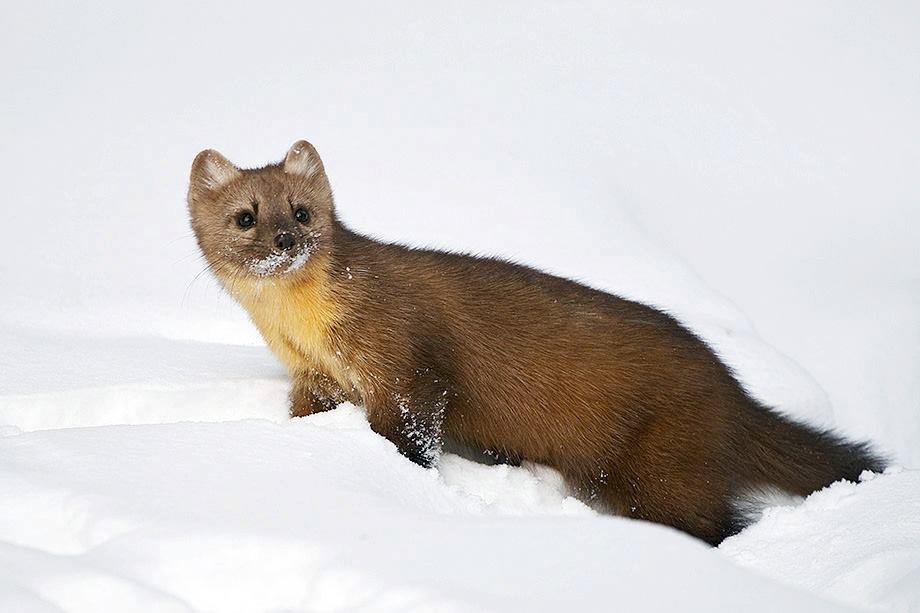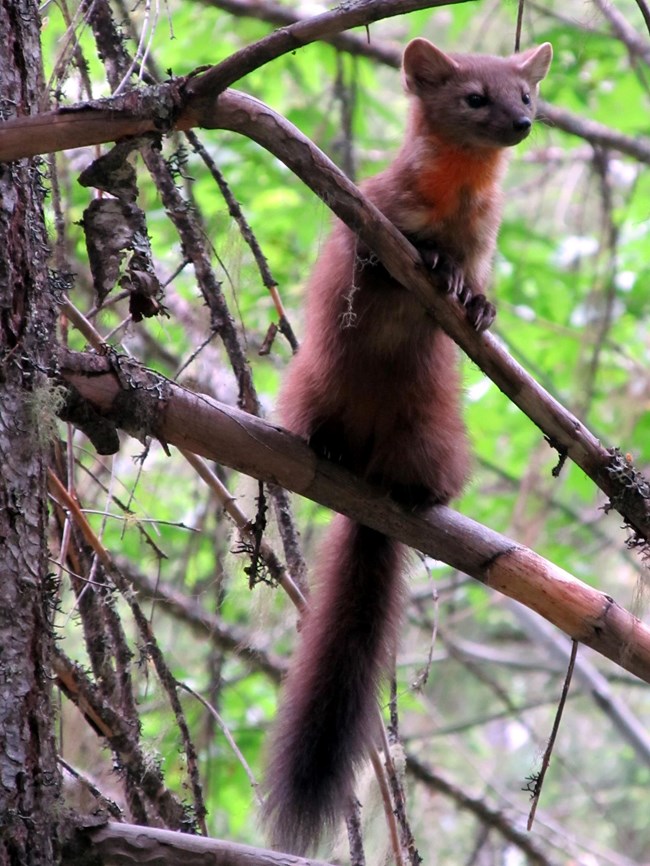Last updated: July 21, 2023
Article
American Marten

NPS
General Description
You’ve seen squirrels and chipmunks scurrying up tree trunks and across branches. But have you ever seen a larger mammal match their nimbleness? American martens (Martes americana) are a small North American mammal in the Mustelidae family, a diverse family that includes weasels, sea otters, and even—the significantly larger—wolverines. American martens have short legs, black eyes, large, round ears, and curved claws that help them climb trees. Their bodies can grow to 35–43 cm (14–17 in) in length with a tail that is 18–23 cm (7–9 in), and adults weigh 1–2 kg (2–4 lbs). They typically have yellowish brown fur, with dark brown fur on their legs and tails along with a throat patch that is white or yellow.
Habitat and Distribution
American martens are widespread around the northern part of North America, including forests of Alaska and Canada down to northern New Mexico. Their geographic range includes the Olympic Mountains, Cascade Range, Blue Mountains of Washington, and high elevations in Oregon. They prefer dense forests and tend to live on shore pines (Pinus contorta) and fir trees. Trees are an essential part of their habitat because they build dens inside empty tree hollows. They can also shelter in burrows that other animals leave behind.
Behavior and Diet
These largely nocturnal animals live a solitary lifestyle and are highly territorial. Due to their solitary nature, martens are usually silent; however, they can communicate with other martens using a variety of sounds that include huffs, chuckles, and shouts. They use odorous glands to mark trees, which signals their territory to other martens.
American martens move across the forest floor in zig-zags and jumps. They also move deftly on trees and can chase prey, including small animals like squirrels, up trees. They feed on small mammals like pikas, chipmunks, and rabbits, and they can eat insects, berries, and parts of mountain ash trees. In addition to moving well on trees, they are strong swimmers, and their light weight and snowshoe-like paws allows them to navigate through snow efficiently.
American martens are well adapted to snowy habitats. During the winter, long hairs grow between the toepads on their feet, an adaptation that keeps them warm and allows them to travel on top of snow, even when the snow is deep and soft. They are also able to travel under snowpack.

NPS
Life History
The life span of American martens is 12–17 years, and they are reproductively mature at 15–24 months. American martens are polygynous, meaning that they have multiple mates. Their breeding season is during the summer, and females give birth to between one and five kits.
Conservation
American martens are an Oregon Conservation Strategy Species. Scientists predict the future loss of snowpack due to climate change, and this loss would threaten American martens by reducing their competitive advantage over other mammals during the winter. Historically, marten fur has been valued highly, and the practice of trapping American martens is another threat.
Fun Facts
• A group of martens is called a “richness.”
• Martens can be distinguished from fishers, another member of the Mustelidae family, because martens are smaller, have orange on their throats and chests, and have pointier ears and snouts. Both martens and fishers are larger and have bushier tails than weasels and minks.
• Sometimes American martens are incorrectly called “pine martens” because of their resemblance to their European relatives.
Where to See
American martens live in Crater Lake National Park, Lassen Volcanic National Park, Oregon Caves National Monument, and Whiskeytown National Recreation Area.
Learn More
Download a pdf of this article.

Prepared by Jeri Stoller, Scientists in Parks intern
NPS Klamath Inventory & Monitoring Network
Southern Oregon University
1250 Siskiyou Blvd
Ashland, OR 97520
Featured Creature Edition: July 2023
